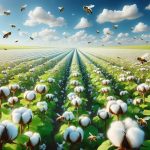When you think about high-quality textiles, Pima cotton likely comes to mind, especially given its prominence in the USA's Southwestern states. You might be surprised to learn about the advanced farming techniques that support its cultivation, such as drip irrigation and integrated pest management. As you consider the economic impact of this luxurious fiber, including job creation and international trade, it raises questions about sustainability practices and what the future holds for Pima cotton production. What challenges and innovations lie ahead in this vital industry?
Table of Contents
History of Pima Cotton
Pima cotton, known for its superior quality, has roots that trace back to ancient civilizations in the Americas, where it was first cultivated by indigenous peoples. These communities recognized the fiber's exceptional properties and used it to create textiles that were both functional and beautiful.
As time progressed, Pima cotton made its way into the hands of European settlers, who admired its softness and durability.
In the early 20th century, the U.S. began to commercialize Pima cotton, particularly in the Southwest, where the climate proved favorable for its growth.
You might find it surprising that the name “Pima” originates from the Pima Indians, who played a significant role in its cultivation. Their traditional practices helped to enhance the quality of this cotton, setting it apart from others.
Cultivation Techniques
Successful cultivation of Pima cotton relies on a combination of optimal soil conditions, precise irrigation practices, and careful management of pests and diseases.
First, you'll want to ensure your soil is well-draining and rich in organic matter. Conduct a soil test to determine pH levels and nutrient content, adjusting as necessary to create the best environment for Pima cotton.
Next, focus on irrigation. Pima cotton thrives in areas with consistent moisture, so implementing a drip irrigation system is often beneficial. This method not only conserves water but delivers it directly to the roots, promoting healthy plant growth. Monitor soil moisture regularly to avoid over- or under-watering.
Pest and disease management is crucial too. Keep a close eye on common pests like aphids and spider mites, as well as diseases such as root rot. You might consider integrated pest management (IPM) strategies, which include using beneficial insects and crop rotation to reduce pest populations naturally.
Economic Impact
The economic impact of Pima cotton production is significant, influencing local economies and the agricultural market in the USA. When you consider the high-quality fibers produced, it's clear that Pima cotton generates substantial revenue for farmers and contributes to job creation in rural areas. The demand for this luxurious cotton drives investments in farming technology and infrastructure, which benefits the entire agricultural sector.
Here's a quick overview of the economic benefits associated with Pima cotton:
| Economic Benefit | Description |
|---|---|
| Revenue Generation | High market value boosts farmers' income. |
| Job Creation | Supports agricultural and textile jobs. |
| Investment in Technology | Encourages modern farming methods. |
| Local Business Growth | Increases demand for local services. |
| Export Opportunities | Expands international trade potential. |
Sustainability Practices
Sustainability practices in Pima cotton production focus on reducing environmental impact while maintaining high-quality yields.
You'll find that many growers are adopting integrated pest management (IPM) techniques. By using natural predators and monitoring pest populations, they minimize pesticide use, which benefits both the ecosystem and the cotton quality.
Water conservation is another key practice. Techniques like drip irrigation ensure that water is used efficiently, reducing waste and helping to maintain soil health.
Additionally, many farmers are implementing cover cropping and crop rotation strategies. These practices improve soil fertility and reduce erosion, leading to healthier crops over time.
You might also notice that more producers are turning to organic fertilizers and compost. These alternatives not only enrich the soil but also reduce reliance on synthetic inputs, promoting a more sustainable farming system.
Moreover, energy-efficient machinery and renewable energy sources are becoming popular among Pima cotton growers, further decreasing their carbon footprint.
Incorporating these sustainability practices not only enhances the overall quality and yield of Pima cotton but also fosters a healthier environment, making a positive impact for future generations.
As you explore the world of Pima cotton, you'll see how these practices are shaping the industry.
Future of Pima Cotton
Looking ahead, Pima cotton is poised to thrive as advancements in technology and sustainable farming practices reshape the industry.
You're likely to see innovations like precision agriculture becoming more widespread, helping farmers optimize water usage and reduce pesticide reliance. These technologies not only improve yields but also enhance the quality of the cotton, ensuring that it remains a premium product.
As consumer demand for sustainable textiles grows, Pima cotton's eco-friendly attributes will draw more attention. You'll find brands increasingly promoting their use of organic and sustainably sourced Pima, catering to eco-conscious shoppers. This trend could lead to a robust market expansion for Pima cotton.
Additionally, collaborations between farmers, researchers, and agricultural organizations will likely yield new strains that are even more resilient to climate change and pests.
Frequently Asked Questions
What Distinguishes Pima Cotton From Regular Cotton Varieties?
Pima cotton's distinguished by its longer fibers, making it softer and more durable than regular cotton. You'll notice its luxurious feel, vibrant colors, and resistance to fraying, which enhance its appeal for high-quality textiles.
How Does Climate Affect Pima Cotton Yield?
Climate significantly impacts pima cotton yield. If temperatures are too high or rainfall is inconsistent, you'll notice reduced growth and fiber quality. Proper conditions ensure healthy plants, leading to optimal yields and superior fiber characteristics.
Are There Any Health Benefits Linked to Pima Cotton Products?
Yes, Pima cotton products offer health benefits. They're hypoallergenic, reducing the risk of skin irritation. Their breathability helps regulate temperature, making them comfortable for sensitive skin. You'll appreciate the softness and durability too!
What Are Common Uses for Pima Cotton Beyond Textiles?
You'll find Pima cotton used in various applications beyond textiles. It's used for high-quality home goods, medical supplies, and even luxury paper products, thanks to its softness, durability, and hypoallergenic properties that cater to diverse needs.
How Can Consumers Identify Genuine Pima Cotton Products?
To identify genuine Pima cotton products, look for labels that specify "100% Pima" or "Supima." Check for a soft, smooth texture, and recognize that reputable brands often highlight their use of this premium cotton.
- Tetron Fabric for Marine Applications: Durability and Use Cases - June 18, 2025
- Tetron Fabric for Outdoor Furniture: Weather Resistance and Care - June 18, 2025
- Tetron Fabric for Wall Coverings: Style and Application Tips - June 18, 2025





